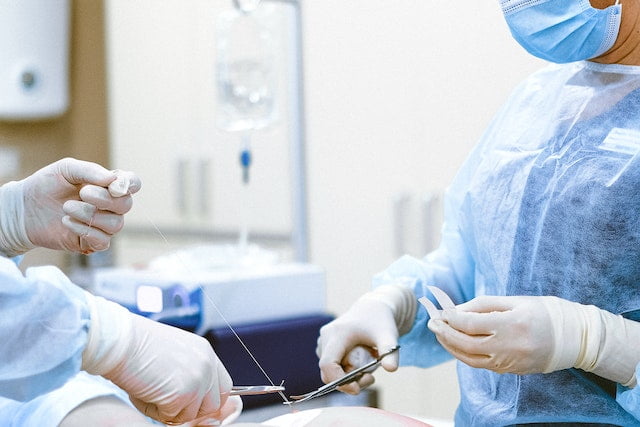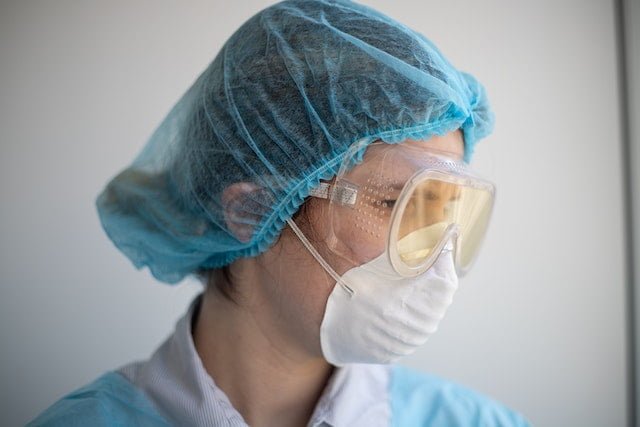Healthcare facilities can become the epicenters of infections if proper focus is not given to their cleaning, disinfection, and sanitization. These practices, recommended by the respective healthcare authorities, are to ensure the safety of the patients as well as the healthcare staff. However, as healthcare personnel are considered our ‘first line of defense’ against diseases, protecting them from acquiring diseases while dealing with them is essential. In this regard, the use of personal protective equipment is highly emphasized. Let us understand what it is, what the right way of PPE use is, and what points out to be considered for its disposal afterward.

PPE use during a surgical procedure
What is PPE?
PPE stands for personal protective equipment which refers to the specialized equipment or clothing donned by the healthcare professionals to prevent or minimize the chances of exposure to biological or chemical hazards. PPE acts as a shield that protects the physician, nurses, and technicians against the possible acquiring of an infection while dealing with an infected patient.
Importance of PPE use in healthcare setups
Personal protective equipment aids the process of protecting the healthcare staff from getting infected by limiting the inhalation and absorption of harmful biological or chemical agents. PPE also reduces the risk of irritation or transmission of infections thus rendering the healthcare facilities safe for the workforce.
Best practices regarding donning and doffing of PPE
Where the use of PPE is well-established in healthcare facilities, emphasis has also been given to the right ways of employment. This includes the correct sequence of the donning and doffing of PPE which maximizes the benefits while reducing the risks. Proper steps to don the PPE include the following:
Hand hygiene:
Hand hygiene should be given priority. The healthcare providers must wash their hands before putting on sterile personal protective gear. For this purpose, hands are to be washed with soap and water for at least 20 seconds or sanitized using a sanitizer that has not less than 60% alcohol.
Shoe covers:
Shoe covers are donned to protect the shoes from the contaminants that are present on the floor. It should be made sure that the shoe covers are not making your feet slippery.
Gown:
The gown is worn next. Its purpose is to protect the wearers from any kind of splashes, fluids, or infectious materials that come their way while handling a patient.
Face protection:
A mask or respirator is the next thing on the list. This ensures that the healthcare personnel has the necessary facial protection. For this purpose, a mask, a respirator (preferably N95), or a face shield can be used.
Eye protection:
Protection of the eyes is recommended to prevent them from receiving any kind of splashes of fluids or blood. It includes the use of goggles which must be comfortable to wear without irritating the skin.
Hand protection:
Gloves are the last item on this list. They are the last barrier against germs. Sterile gloves, chosen according to the size required by the healthcare professional, should be worn just before the procedure.

Masks and respirators
A wide range of personal protective equipment is available at Health Supply 770 which can be accessed by simply clicking on their website.
Once the intended job has been done, the PPE is to be removed with care as now it has contaminants and infectious materials on it. Therefore, by being careful, contamination can be avoided. While doffing the PPE, the following sequence should be followed:
- Shoe covers
- Gown and gloves
- Hand hygiene (Washing or sanitization)
- Eye protection
- Mask or respirator
How to avoid common mistakes regarding PPE use?
To ensure the proper use of PPE, the a need to train healthcare providers by arranging sessions of personal protection or by the employment of simulation-based mastery learning (SBML) technique which, although new, has promising outcomes. This way, common mistakes regarding PPE use can be avoided which usually include the following:
Wrong equipment:
The right kind of equipment should be selected according to the environment where it needs to be used. If one has to deal with open wounds or perform an open surgery, complete coverage is required. If not, the exposed surfaces are to be covered with an oil-based waterproof dressing which can be removed later on. This practice can diminish the incidence of an infection.
Wrong size:
PPE should be chosen depending on the healthcare professional who is going to use it. Wearing too big or too small clothing compromises the safety of the wearer. Fit testing can be done before using the PPE at the time of medical procedure.
Wrong method of donning and doffing:
PPE should be used according to the steps detailed above. If a personnel deviates from the recommended methods of donning and doffing of PPE, acquiring an infection becomes highly likely.
Wrong method of disposal:
First and foremost, the removal of PPE is to be done in the doffing area which is a special space designated for this purpose. It should be ensured that no direct contact is made with the used PPE while or after its doffing. Biohazard bins are to be used to discard biomedical waste. Moreover, all of these bins as well as the doffing area must be subjected to disinfection from time to time.

Proper use of PPE ensures maximum protection against potential hazards
Conclusion
Healthcare personnel including physicians, nurses, interns, pediatricians, dentists, pharmacists, as well as medical lab technicians are at high risk of being sick due to their job of dealing with diseased individuals.
Apart from the guidelines regarding the thorough cleaning of the healthcare spaces, it is also important to focus on protecting the staff by implementing the proper use of personal protective equipment.
The use of a single mask by a healthcare worker can reduce the chances of infection. Taking it as a base, the impact of proper coverage while working in hospitals can be estimated. After all, a flourishing healthcare system can only be achieved by the services of safe and protected healthcare staff.

PhD Scholar (Pharmaceutics), MPhil (Pharmaceutics), Pharm D, B. Sc.
Uzma Zafar is a dedicated and highly motivated pharmaceutical professional currently pursuing her PhD in Pharmaceutics at the Punjab University College of Pharmacy, University of the Punjab. With a comprehensive academic and research background, Uzma has consistently excelled in her studies, securing first division throughout her educational journey.
Uzma’s passion for the pharmaceutical field is evident from her active engagement during her Doctor of Pharmacy (Pharm.D) program, where she not only mastered industrial techniques and clinical case studies but also delved into marketing strategies and management skills.
Throughout her career, Uzma has actively contributed to the pharmaceutical sciences, with specific research on suspension formulation and Hepatitis C risk factors and side effects. Additionally, Uzma has lent her expertise to review and fact-check articles for the Health Supply 770 blog, ensuring the accuracy and reliability of the information presented.
As she continues her PhD, expected to complete in 2025, Uzma is eager to contribute further to the field by combining her deep knowledge of pharmaceutics with real-world applications to meet global professional standards and challenges.








